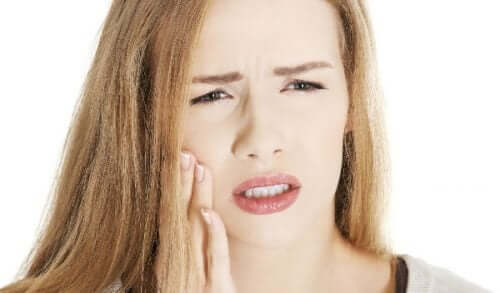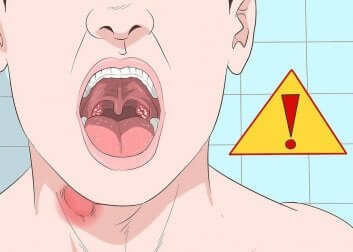Characteristics of Canker Sores in the Throat

Canker sores in the throat are small lesions and their appearance is related to the deficient functioning of the immune system.
Continue reading to learn more about their causes and treatments, as this article will tell you more about some medical guidelines.
What are canker sores in the throat?
The actual disorder is called “aphthous stomatitis” or “aphthosis.” It usually afflicts teenagers although it can also manifest in adults. It could be a single lesion or several at the same time.
Canker sores are yellowish-white with a reddish rim and they usually go away within a week. There are times when they produce discomfort such as burning or pain, and there may even be a small lump.

This benign condition can become chronic and lead to several outbreaks a year and, in some cases, it leads to other serious and complex disorders. The pain while eating can be so intense it could even lead to significant weight loss.
Causes of canker sores in the throat
The origin of this condition isn’t clear yet but we do know it has to do with the immune system. These are some of the causes:
- People afflicted by canker sores have a certain family predisposition for them, and studies reveal that several members of the same family can have them.
- There’s no scientific proof, but some researchers believe these are due to the sort of emotional stress that affects the immune system and thus predisposes a person to have them.

- Trauma in the oral mucosa as a result of involuntary bites is also a trigger
- Low levels of iron, folic acid, or vitamin B12 have been detected in some people with canker sores
- This condition is also associated with acidic food intake and gastroesophageal reflux
- They could be due to certain food allergies, especially those caused by sodium lauryl sulfate in toothpaste
Curious facts about the medical evolution of canker sores
These factors might be the culprits of canker sores in the throat. However, it’s idiopathic (of unknown origin) in most cases.
Researchers are currently considering this data:
- It isn’t an infectious disease
- It isn’t produced by the herpes virus
- Finally, it isn’t contagious
You might be interested in Mouth Ulcers or Sores: Everything You Need to Know
Canker sores in the throat disappear after identifying and treating the cause, but doctors turn to symptomatic and supportive treatments to relieve the pain or discomfort when it doesn’t work.

You must resort to pharmacological treatments when hygienic measures fail to prevent the problem. Let’s emphasize it’ll be necessary to make a differential diagnosis with pathologies that produce these lesions. A doctor can do a biopsy, among other things.
Thus, you must consult a medical professional; don’t self-medicate as it could mask your symptoms and worsen the prognosis.
In the meantime
- Use a soft-bristle toothbrush
- Use mouthwash after tooth brushing to remove any germs
- Decrease the consumption of acidic foods: lemons, tomatoes, kiwis, pineapples etc.
- Avoid excessively spicy foods

Some natural remedies can also soothe discomfort. For example, Dr. Peña recommends propolis extract due to its antibiotic action.
Similarly, an article published by the Journal of the Indian Society of Periodontology highlights the use of marigold for its anti-inflammatory, healing, and also antimicrobial properties.
Pharmacological treatment
In most cases, the treatment doctors usually prescribe are:
- Cyanoacrylate-based ointments to cover the ulcer as it’s like a glue that prevents contact between the lesion and food or saliva
- Topical anesthetics such as lidocaine or benzocaine to relieve pain
- Corticosteroids for topical use as a rinse or applied as an ointment based on fluocinonide, clobetasol, or dexamethasone
- For larger lesions, a medical professional can inject steroids into the ulcer or treat them with a CO2 laser
- The consumption of food high in folic acid, B vitamins, and iron, as well as apples, yogurt, bananas, mangoes, legumes, etc.
- Gargles with either saltwater or hydrogen peroxide have antiseptic properties that can help decrease the symptoms.
Consult a doctor if you don’t improve in a timely manner or if the episodes repeat several times a year as only they can properly diagnose and rule out more serious illnesses.
https://mejorconsalud.as.com/aftas-en-la-garganta-que-son-y-como-se-tratan/
All cited sources were thoroughly reviewed by our team to ensure their quality, reliability, currency, and validity. The bibliography of this article was considered reliable and of academic or scientific accuracy.
- Rioboo García R. Educación para la salud bucodental: Odontología Preventiva y Odontología Comunitaria. Madrid: Avances Méd Dentales; 2002. p. 1321-5.
- Soto Araya M, Rojas Alcayaga G, Esguep A. Asociación entre alteraciones psicológicas y la presencia de Liquen plano oral, Síndrome boca urente y Estomatitis aftosa recidivante. Med Oral Chile. 2004;(9):1-7.
- Casanova Rivero Y, Lima Álvarez M, Casanova Rivero A, Santana Ramírez H. Estrés y su influencia en la Enfermedad Periodontal. Clínica Estomatológica Provincial Docente. Camagüey. Rev AMC. 1997;1(1)
- Pérez Borrego A, Guntiñas Zamora MV, González Labrada A. Estomatitis aftosa recurrente (II Parte). Determinación de marcadores de inmunidad celular. La etiopatogenia de la enfermedad no es totalmente conocida. Rev Mexicana de Odontología Clín. 2008;2(4).
- Gutiérrez Ramos F. Efecto del estrés y del tabaquismo en la estomatitis aftosa recurrente [tesis]. Lima: Universidad Nacional Mayor de San Marcos; 2005 [citado 18 Abr 2009]. Disponible en: http://www.cybertesis.edu.pe/sisbib/2006/gutierrez_rd/pdf/gutierrez_rd-TH.back.1.pdf
- Siriamornpun, S., Kaisoon, O. y Meeso, N. (2012). Cambios en el color, actividades antioxidantes y carotenoides (licopeno, β-caroteno, luteína) de la flor de caléndula (Tagetes erecta L.) como resultado de diferentes procesos de secado. Journal of Functional Foods, 4 (4), 757–766. https://doi.org/10.1016/j.jff.2012.05.002
- Khairnar MS, Pawar B, Marawar PP, Mani A. Evaluación de Calendula officinalis como agente antiplaca y anti-gingivitis. J Indian Soc Periodontol 2013; 17: 741-7
- Ramón Bonet & Antonieta Garrote (2015). Aftas bucales. Farmacia Profesional. https://www.elsevier.es/es-revista-farmacia-profesional-3-articulo-aftas-bucales-X0213932415727469
This text is provided for informational purposes only and does not replace consultation with a professional. If in doubt, consult your specialist.









